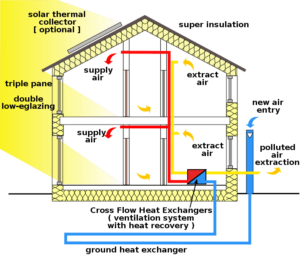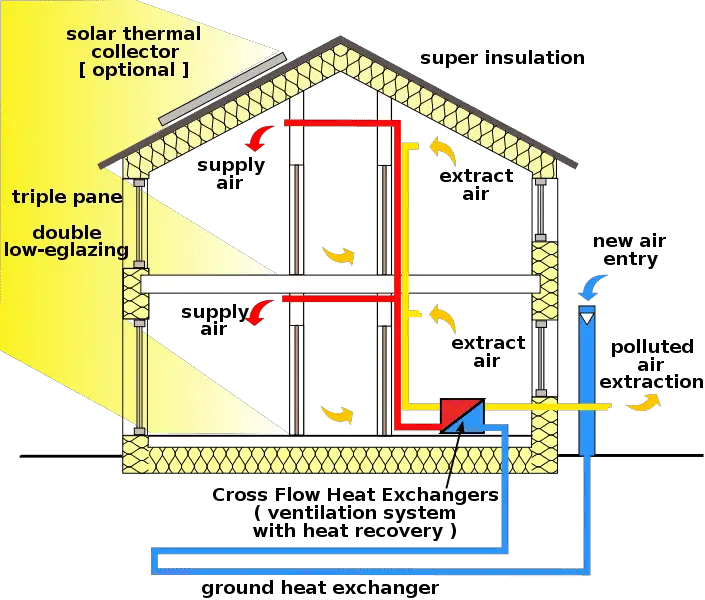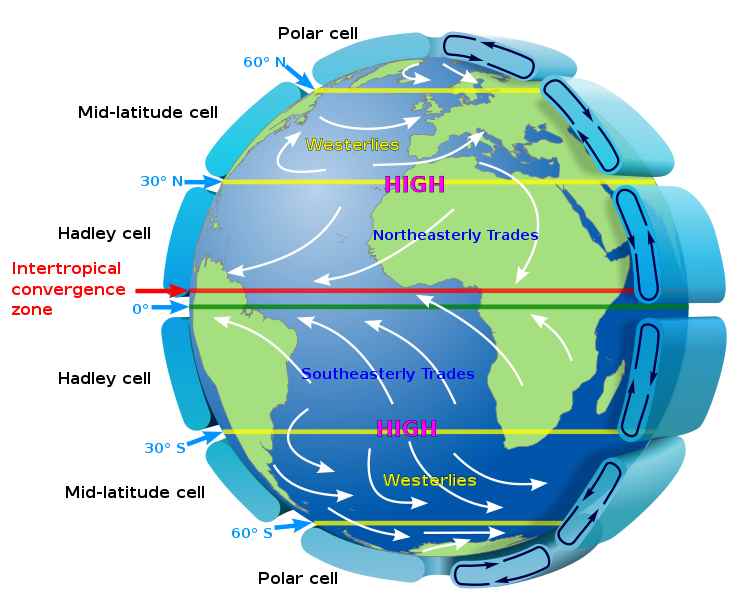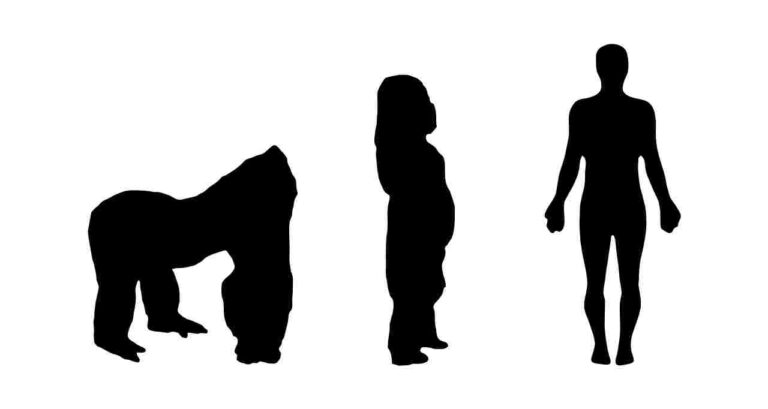Passive Vs Active Solar Energy Comparison Using Multiple (7) Criteria
Passive vs active solar energy is the comparison of similarities and differences between passive and active solar energy systems, and can be carried out based on criteria like mechanism, systems, determinant factors, area(s) of relevance, relative cost, limitations, and examples.
This article shows the similarity and difference between passive and solar energy applications, as follows;
1). Mechanism (as a Criterion for Passive Vs Active Solar Energy Comparison)
One of the ways to explain the difference between passive and active solar energy is by highlighting the variations in mechanisms involved, for each method.
Passive solar works by capturing solar electromagnetic radiation in an unaided manner that is similar to the mechanism of solar energy utilization in natural ecosystems.
Instead of complex technological systems, passive solar utilizes building components as passive energy storage systems to absorb and reserve solar energy in its thermal form [3], so that it may be used for purposes like heating and cooling as a substitute for electricity.
The use of passive solar heating can be seen as an energy conservation measure, and is linked to sustainable development concepts like green building and green energy-harnessing.
Active solar works by the use of hydrodynamic energy storage and cycling; whereby a working fluid absorbs solar heat and transfers it by conductive, convective and radiant energy transfer mechanisms, to the point of use. It is called 'active' due to the presence of a working fluid that is often circulated using a pump [2].
The main difference between passive and active solar heating in terms of mechanism, is the use of working fluids (liquid or gaseous) in active solar heating.

Active solar is often considered to be better than passive in terms of efficiency and effectiveness, as the fluids help to minimize energy losses that may occur in the process of storage and transfer.
2). Systems
A passive solar system is a collection of components and materials that capture solar thermal energy in a manner that is applicable for heating and cooling, without the use of mechanical, piezoelectric or photoelectric (such as solar panels) devices.
An active solar system is a renewable energy system that is designed to capture and transfer solar heat by the mechanical and thermodynamic processes of a working fluid.
Passive solar systems basically use the structural components of a building to harness solar energy, meaning that the effectiveness of passive solar capture depends on the architectural design and components of the building(s) involved.
It is common for passive solar systems to be described as not requiring any 'external devices', which is to mean that the level of complexity of these systems is relatively low.
Active solar systems are more complex than passive systems because of the need to install 'external' devices like conduits, fluid-storage vessels and pumps.

3). Determinant Factors (as a Criterion for Passive Vs Active Solar Energy Comparison)
Another way to illustrate the difference between passive and active solar energy concepts is by highlighting the various factors on which solar output depends, for each case.
Passive solar energy is design-dependent; meaning that the efficiency of passive solar capture and utilization, is proportional to the efficiency of architectural design, of the building or structure where it is being used.
In passive solar heating, energy is absorbed through materials like glass and apertures like windows, and is stored and modified using walls, ceiling materials and green roofs, among other building elements [5].
The determinant factors that affect passive solar heating are therefore; building design conditions including aperture positions and sizes, as well as materials used for walls, windows and roofs.
On the other hand, active solar energy is dependent on the external components and devices used to capture and transfer or convert solar energy.
Factors that determine the output of active solar energy are; type and volume of working fluid, technological design, presence/absence and power of pumps, conduit material and size, vessel size, and mode of fluid circulation.
4). Area(s) of Relevance
The purpose of passive solar concept is to combine sustainable building with clean energy utilization.
Passive solar is most used where the climate, location, materials and architectural design of a building are advantageous and can be exploited to reduce energy costs.
It is relevant for indirect and direct solar capture and usage in water and space heating applications.
The uses of active solar energy include heat storage, water heating, as well as space heating and cooling [1].
Because of its higher effectiveness and complexity, active solar has a broader area of relevance than passive solar capture. In large-scale active solar systems with sufficient solar heat, a turbine can be integrated, for electricity generation. Other applications such as cogeneration, and hybrid energy resource-usage can also be implemented under active solar energy, although this is less-common.
5). Relative Cost (as a Criterion for Passive Vs Active Solar Energy Comparison)
Active solar heating systems are more expensive than passive solar heating systems in general, because they require external devices to be integrated into a building structure.
The cost of passive solar energy is relatively low because it does not involve additional equipment to a building, but only requires certain design considerations to be made.
Constricting a passive solar building rarely increases the cost by more than 3% above that of a building that is constructed without passive solar design-considerations.
The only condition under which passive solar can involve significant investment is when it is being implemented on an already-existing building, because this will involve demolition, reconstruction and replacement procedures.
On the other hand, active solar systems can cost up to $10,000 (USD) and above, because they are composed of multiple external (that is; non-building) components and devices.
Active solar systems are also more expensive because they require more specialized knowledge for their design, installation and maintenance, than passive solar systems.
In spite of higher cost, active solar energy is more cost effective than passive solar because of its higher energy efficiency and output.
6). Limitations
The main advantage of both active and passive solar systems is energy cost-reduction, as these systems complement conventional energy resources and systems like fossil fuels and electric generators. However, these systems also have some limitations.
Limitations of passive solar systems arise from the fact that they are generally incapable of converting solar energy to other forms such as mechanical energy and electricity. Passive solar has limited application that covers mostly space and water heating.
Another disadvantage of passive solar is that it directly influences the architectural model of a building, and can require design decisions that may not be favorable in other areas such as navigation.
The limitations of active solar energy include dependence on external devices like pumps and solar concentrators, and restriction to mostly heating applications (although electricity generation is also possible).
Both passive and active solar heating systems are limited in terms of weather and time-dependence, as solar energy is available only under favorable weather (or climatic) conditions, and in the daytime.
Generally, the energy cost reductions that can be achieved using passive and active solar systems are sufficient to make up for their limitations [4].
7). Examples (as a Criterion for Passive Vs Active Solar Energy Comparison)
Examples of active and passive solar energy can be used as one of the criteria for their comparison.
Two (2) examples of passive solar energy systems are; heat-absorbent surfaces (floors, walls and ceilings), and sunlight-receptive windows.
Two (2) examples of active solar energy systems are; solar water heaters, and concentrated solar power systems.
Passive solar energy examples differ from active solar energy examples, by being part of the basic structure of buildings, whereas active solar examples are all non-building devices and components.
Conclusion
Passive vs active solar energy can be compared based on various criteria including; mechanism, systems, determinant factors, area(s) of relevance, relative cost, limitations, and examples.
The table below summarizes the difference between passive and active solar energy based on multi-criteria comparison;
Comparison Criterion | Passive Solar | Active Solar |
Mechanism | Direct and Indirect Solar Heating | Solar Heat Storage and Transfer by Working Fluid |
Systems | Relatively Simple, Non External | Relatively Complex, External |
Determinant Factors | Location, Climate, Building Materials and Design | Type of Working Fluid, Circulation Mode, Pump Power, Conduit Material and Size |
Area(s) of Relevance | Space and Water Heating | Heating, Cooling, Electricity Generation |
Relative Cost | Low | High |
Limitations | Design Dependence, Weather Dependence, No Energy Conversion | Weather Dependence, Requirement of External Devices |
Examples | Heat-Absorbent Surfaces (floors, walls, ceilings), Sunlight-Receptive Windows | Solar Water Heater, Concentrated Solar Power Systems |
References
1). Benincá, L.; Cóstola, D.; Kyrou, E. (2017). "A feasibility study on active solar space heating technology for office buildings in Greece." Revista de Engenharia Civil IMED 4(2):89. Available at: https://doi.org/10.18256/2358-6508.2017.v4i2.2281. (Accessed 18 April 2023).
2). Caouris, Y. G. (2011). "Active solar heating systems design." SOLAR THERMAL CONVERSION, Active Solar Systems. Available at: https://www.researchgate.net/publication/264162738_Active_solar_heating_systems_design. (Accessed 18 April 2023).
3). Cillari, G.; Fantozzi, F.; Franco, A. (2021). "Passive Solar Solutions for Buildings: Criteria and Guidelines for a Synergistic Design." Appl. Sci. 2021, 11, 376. Available at: https://doi.org/10.3390/app11010376. (Accessed 18 April 2023).
4). Kazmeyer, M. (2023). "The Advantages of Passive & Active Solar Technology." Available at: https://sciencing.com/advantages-passive-active-solar-technology-23375.html. (Accessed 18 April 2023).
5). Sobczyk, W.; Sapa, K. (2016). "Energy balance in a passive solar building. An attempt at economic assessment." E3S Web of Conferences 10:00086. Available at: https://doi.org/10.1051/e3sconf/20161000086. (Accessed 18 April 2023).



